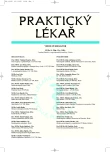-
Medical journals
- Career
Antimicrobial resistance in seven invasive bacterial species* monitored within EARSS in the Czech Republic (CR) from 2000 – 2006. (*Streptococcus pneumoniae, Staphylococcus aureus, Enterococcus faecalis, Enterococcus faecium, Escherichia coli, Klebsiella pneumoniae, Pseudomonas aeruginosa).
Authors: P. Urbášková; V. Jakubů; H. Žemličková; B. Macková; Cz Earss *
Authors‘ workplace: Ředitel: MUDr. Jaroslav Volf, PhD. ; Centrum epidemiologie a mikrobiologie ; Státní zdravotní ústav Praha ; Národní referenční laboratoř pro antibiotika
Published in: Prakt. Lék. 2007; 87(1): 32-39
Category: Of different specialties
Overview
Detailed data on antimicrobial resistance prevalence, status and trends in seven major causative agents of invasive infections were collected within the European Antimicrobial Resistance Surveillance System (EARSS). The strains of E. coli (n=9848), S. aureus (n=8004), S. pneumoniae (n=1065), K. pneumoniae (n=1018), E. faecalis (n=2812), E. faecium (n=705) and P. aeruginosa (n=470) were isolated from 23,922 patients hospitalized between July 2000 and June 2006 in 83 hospitals with a catchment area including 90 % of the population of CR. The bacterial species monitored were detected in patients with invasive infections in the CR with a similar frequency as in other countries, with the exception of S. pneumoniae whose low incidence seems attributable to late or non-collection of blood for culture from community patients. Infections caused by E. coli were more common in females (60 %), while the other monitored causative agents were more frequently detected in males (60 %). Causative species of hospital infections (E. faecalis, E. faecium, P. aeruginosa and K. pneumoniae) typically prevail in ICU and hematooncology patients. About 95 % of patients with bacteremic infection are adults (the rate being 84 % for S. pneumoniae). Almost all S. pneumoniae strains show low resistance to penicillin (MIC 0.125-1 mg/l); in 2006, the rate of erythromycin/macrolide resistant strains (6 %) was higher than that of penicillin resistance (3.4 %) for the first time. The rate of infections caused by oxacillin resistant S. aureus (MRSA) strains in 2006 was four times higher (13.1 %) than it was in 2000 (3.8 %) due to the spread of an epidemic clone. Almost half of E. faecalis strains and 80 % of E. faecium strains appeared highly resistant to gentamicin (MIC > 500 mg/l) and outbreaks of infections caused by vancomycin resistant E. faecium strains have been reported. In E. coli strains, the ciprofloxacin resistance rate tripled over 6 years, reaching 25 % among invasive isolates in 2006.
The most alarming resistance status was found in K. pneumoniae and P. aeruginosa, with both bacteria showing equally high rates of resistance to ciprofloxacin (43.8 % and 45.9 %, respectively), ceftazidime (32.3 % and 35.2 %, respectively) and gentamicin (28.8 % and 28.4%, respectively). The Czech figures are among the highest resistance rates for these two bacterial species reported in 30 European countries.
The increase in the incidence of invasive infections caused by resistant bacterial strains and their rapid spread among Czech hospitals can be ascribed to the failure to comply with antiepidemic measures and the abuse of antibiotics. Remedial measures need to be implemented urgently.Key words:
EARSS, antimicrobial resistance surveillance, invasive bacterial isolates.
Labels
General practitioner for children and adolescents General practitioner for adults
Article was published inGeneral Practitioner

2007 Issue 1-
All articles in this issue
- Patent foramen ovale as a cause of paradoxical embolization in scuba divers. Screening possibilities, therapeutic and preventive recommendation.
- Hypoglycaemia-associated autonomic failure, its clinical assessment and treatment.
- Chronic renal failure in primary care
- Prescription of psychotropic drugs during pregnancy and breast-feeding in the general practitioner’s surgery.
- Wilson’s disease
- Diagnostics and treatment of rheumatoid arthritis – some new aspects
- Biochemical molecular mechanisms of heart failure (Part 2)
- Antimicrobial resistance in seven invasive bacterial species* monitored within EARSS in the Czech Republic (CR) from 2000 – 2006. (*Streptococcus pneumoniae, Staphylococcus aureus, Enterococcus faecalis, Enterococcus faecium, Escherichia coli, Klebsiella pneumoniae, Pseudomonas aeruginosa).
- Childhood injuries and their prevention
- Our experience with the treatment of acute mesenterial ischemia
- Craniopharyngioma in 79 years old man – a case study
- General Practitioner
- Journal archive
- Current issue
- Online only
- About the journal
Most read in this issue- Chronic renal failure in primary care
- Craniopharyngioma in 79 years old man – a case study
- Wilson’s disease
- Hypoglycaemia-associated autonomic failure, its clinical assessment and treatment.
Login#ADS_BOTTOM_SCRIPTS#Forgotten passwordEnter the email address that you registered with. We will send you instructions on how to set a new password.
- Career

